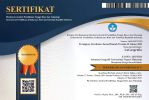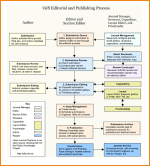Tingkat Rawan Longsor di Daerah Aliran Sungai Jenelata Sub Das Jeneberang Kabupaten Gowa
(1) Universitas Negeri Makassar, Indonesia
(2) Universitas Negeri Makassar, Indonesia
(*) Corresponding Author
DOI: https://doi.org/10.35580/lageografia.v21i3.53968
Abstract
Various disasters continuously hit Indonesia. This disaster caused loss of life, property, and land damage which had an impact on people's lives. The aim of this research is to describe the level of landslide hazard in the Jenelata watershed, the Jeneberang sub-watershed of Gowa Regency. The methods used are Remote Sensing techniques and Geographic Information Systems (GIS). The research results show that most of the Jenelata watershed area is in the moderate class of landslide hazard level covering an area of 15,581.37 hectares (66.53%). Spread throughout the watershed area, but dominant in the middle to downstream parts. The very high class is spread downstream of the Jenelata Sub-watershed. The variables that determine the level of landslide danger are related, but the dominant ones are rainfall, slope slope, and soil type. In managing land in the Jenelata watershed area, we need to be careful not to increase the landslide disaster class to a vulnerable one.
Abstrak
Indonesia bertubitubi dilanda berbagai bencana. Bencana tersebut menimbukan kerugian, nyawa, harta benda dan kerusakan lahan yang berdampak pada kehidupan masyarakat. Tujuan penelitian ini yaitu menggambarkan tingkat rawan longsor di DAS Jenelata sub DAS Jeneberang Kab Gowa. Metode yang digunakan yaitu teknik Penginderaan Jauh dan Sistem Informasi Geografis (SIG). Hasil penelitian menunjukkan sebagian besar wilayah DAS Jenelata berda pada kelas tingkat rawan bencana longsor kelas sedang seluas 15.581,37 Ha (66,53 %). Tersebar seluruh wilayah DAS, namun dominan di bagian tengah hingga hilir. Kelas sangat tinggi tersebar di hilir Sub DAS Jenelata. Variabel yang menentukan tingkat bahaya longsor saling terkait satu sama lain, namun yang dominan yaitu: curah hujan, kemiringan lereng, dan jenis tanah. Dalam pengelolaan lahan wilayah DAS Jenelata perlu hati-hati jangan memicuh meningkatnya kelas bencana longsor menjadi kelas sangat rawan.
Keywords
Full Text:
PDFReferences
Adji, T. N., & Sejati, S. P. (2014). Identification of groundwater potential zones within an area with various geomorphological units by using several field parameters and a GIS approach in Kulon Progo Regency, Java, Indonesia. Arabian Journal of Geosciences, 7(1), 161–172. https://doi.org/10.1007/s12517-012-0779-z
Arifin, S., Carolila, I., & Winarso, G. (2006). Implementasi penginderaan jauh dan SIG untuk inventarisasi daerah rawan bencana longsor (Propinsi Lampung). Jurnal Penginderaan Jauh, 3(1), 77-86.
Baharuddin, I. I., Badwi, N., & Darwis, M. (2021). Spatial Analysis of Water Springs Potential in Sub Drainage Basin Hulu Jeneberang South Sulawesi Province. Journal of Physics: Conference Series, 1899(1), 12064.
Bangun, Y., Simanjuntak, B. H., & Sutrisno, A. J. (2021). Analisis Perubahan Penggunaan Lahan Sawah dari Tahun 2008 – 2018. LaGeografia, 19(3), 302. https://doi.org/10.35580/lageografia.v19i3.20118
Biasutti, M. (2019). Rainfall trends in the African Sahel: Characteristics, processes, and causes. Wiley Interdisciplinary Reviews: Climate Change, 10(4), e591.
Cantarino, I., Carrion, M. A., Goerlich, F., & Martinez Ibañez, V. (2019). A ROC analysis-based classification method for landslide susceptibility maps. Landslides, 16, 265–282.
Darwis, M. R., Uca, U., & Yusuf, M. (2021). PEMETAAN ZONASI DAERAH RAWAN BENCANA LONGSOR BERBASIS SISTEM INFORMASI GEOGRAFI DI DASJENEBERANG KABUPATEN GOWA. Jurnal Environmental Science, 3(2).
Dibyosaputro, S. (1999). Longsorlahan Di Daerah Kecamatan Samigaluh, Kabupaten Kulon Progo, Daerah Istimewa Yogyakarta. Majalah Geografi Indonesia, 16(2), 13–34.
Edy, R., Hasan, A. A., & Sofyan, A. (2022). Evaluasi Kesesuaian Lahan Untuk Tanaman Ubi Kayu (Manihot esculenta) di DAS Gufasa. Jurnal Pertanian Khairun, 1(2). https://doi.org/10.33387/jpk.v1i2.5561
Fiorini, A., Boselli, R., Maris, S. C., Santelli, S., Perego, A., Acutis, M., Brenna, S., & Tabaglio, V. (2020). Soil type and cropping system as drivers of soil quality indicators response to no-till: A 7-year field study. Applied Soil Ecology, 155, 103646.
Fowler, H. J., Lenderink, G., Prein, A. F., Westra, S., Allan, R. P., Ban, N., Barbero, R., Berg, P., Blenkinsop, S., & Do, H. X. (2021). Anthropogenic intensification of short-duration rainfall extremes. Nature Reviews Earth & Environment, 2(2), 107–122.
Hadmoko, D. S., Lavigne, F., Sartohadi, J., & Hadi, P. (2010). Landslide hazard and risk assessment and their application in risk management and landuse planning in eastern flank of Menoreh Mountains, Yogyakarta Province, Indonesia. Natural Hazards, 54(3), 623–642.
Hazell, J., Herreno, J., Nakamura, E., & Steinsson, J. (2022). The slope of the Phillips Curve: evidence from US states. The Quarterly Journal of Economics, 137(3), 1299–1344.
Intrieri, E., Carlà, T., & Gigli, G. (2019). Forecasting the time of failure of landslides at slope-scale: A literature review. Earth-Science Reviews, 193, 333–349.
Iqbal, P. (2018). Geologi Kuarter dan Cuaca Daerah Lampung Barat, Kaitannya dengan Kejadian Longsor (Studi Kasus Jalur Jalan Transek Lampung Barat). Jurnal Geologi Dan Sumberdaya Mineral, 19(3), 163–169.
Karlina, I. I. (2016). Analisis Tingkat Kerawanan Longsor Pada Sebagian Jalan Kelas Iiic Di Sub- Das Gesing, Kabupaten Purworejo, Jawa Tengah. Universitas Gadjah Mada.
Kavzoglu, T., Colkesen, I., & Sahin, E. K. (2019). Machine learning techniques in landslide susceptibility mapping: a survey and a case study. Landslides: Theory, Practice and Modelling, 283–301.
Kotz, M., Levermann, A., & Wenz, L. (2022). The effect of rainfall changes on economic production. Nature, 601(7892), 223–227.
Kurniawan, R., Mahtarami, A., & Rakhmawati, R. (2017). GEMPA: Game Edukasi sebagai Media Sosialisasi Mitigasi Bencana Gempa Bumi bagi Anak Autis. Jurnal Pendidikan Dan Pembelajaran Universitas Negeri Malang, 6(1), 115–120. http://studentjournal.petra.ac.id/index.php/desain-interior/article/view/2146
Le Coz, C., & Van De Giesen, N. (2020). Comparison of rainfall products over sub-saharan africa. Journal of Hydrometeorology, 21(4), 553–596.
Long, H., Zhang, Y., Ma, L., & Tu, S. (2021). Land use transitions: Progress, challenges and prospects. Land, 10(9), 903.
Lusy, I., Suwarni, N., Miswar, D., & Jaya, M. T. B. S. (2020). Pemodelan Bencana Longsor Berbasis Spasial. LaGeografia, 19(1), 16–27.
Marwah, S. (2014). Analysis of Land Use Changes and Water Resource Availability in Konaweha Watershed Southeast Sulawesi Province. Jurnal Agroteknos, 4(3), 208–218.
Morgan, R. P. C., & Rickson, R. J. (2003). Slope stabilization and erosion control: a bioengineering approach. Taylor & Francis.
Nasiah., & Ichsan, I. (2015). Identifikasi Daerah Rawan Bencana Longsor Lahan Sebagai Upaya Penanggulangan Bencana di Kabupaten Sinjai. Sainsmat: Jurnal Ilmiah Ilmu Pengetahuan Alam, 3(2).
Nasiah., & Sakina. (2022) Daerah Rawan Bencana Longsor di DAS Takapala Sub DAS Jeneberang Hulu Kab Gowa Provinsi Sulawesi Selatan. Jurnal Lageografia Vol 20 No.3 Tahun 2022.
Nasiah., & Invanni, I. (2013). Zonasi Daerah Rawan Bencana Longsor di Sulawesi Selatan.
Nursa’ban, M. (2010). Identifikasi Kerentanan dan Sebaran Longsor Lahan Sebagai Upaya Mitigasi Bencana di Kecamatan Bener Kabupaten Purworejo. Jurnal Geografi Gea, 10(2).
O’Brien, P. E., Post, A. L., Edwards, S., Martin, T., Caburlotto, A., Donda, F., Leitchenkov, G., Romeo, R., Duffy, M., Evangelinos, D., Holder, L., Leventer, A., López-Quirós, A., Opdyke, B. N., & Armand, L. K. (2020). Continental slope and rise geomorphology seaward of the Totten Glacier, East Antarctica (112°E-122°E). Marine Geology, 427, 106221. https://doi.org/10.1016/j.margeo.2020.106221
Peethambaran, B., Anbalagan, R., Kanungo, D. P., Goswami, A., & Shihabudheen, K. V. (2020). A comparative evaluation of supervised machine learning algorithms for township level landslide susceptibility zonation in parts of Indian Himalayas. Catena, 195, 104751.
Poedjiastoeti, H., Sudarmadji, S., Sunarto, S., & Suprayogi, S. (2017). Penilaian Kerentanan Air Permukaan terhadap Pencemaran di Sub DAS Garang Hilir Berbasis Multi-Indeks. Jurnal Wilayah Dan Lingkungan, 5(3), 168. https://doi.org/10.14710/jwl.5.3.168-180
Sugianti, K., Mulyadi, D., & Sarah, D. (2014). Klasifikasi Tingkat Kerentanan Gerakan Tanah Daerah Sumedang Selatan Menggunakan Metode Storie. Riset Geologi Dan Pertambangan, 24(2), 91–102.
Syamsuri, U. A., Nasiah, N., & Maru, R. (2021). PEMETAAN TINGKAT KEKERINGAN LAHAN SAWAH BERBASIS SISTEM INFORMASI GEOGRAFIS DI KABUPATEN TAKALAR. Jurnal Environmental Science, 3(2). https://doi.org/10.35580/jes.v3i2.20024
Verburg, P. H., Alexander, P., Evans, T., Magliocca, N. R., Malek, Z., Rounsevell, M. D. A., & van Vliet, J. (2019). Beyond land cover change: towards a new generation of land use models. Current Opinion in Environmental Sustainability, 38, 77–85.
Wang, J., Bretz, M., Dewan, M. A. A., & Delavar, M. A. (2022). Machine learning in modelling land-use and land cover-change (LULCC): Current status, challenges and prospects. Science of the Total Environment, 822, 153559.
Warren, C. R. (1955). Principles of Geomorphology. William D. Thornbury. Wiley, New York; Chapman & Hall, London, 1954. ix+ 618 pp Warren, C. R. (1955). Principles of Geomorphology. William D. Thornbury. Wiley, New York; Chapman & Hall, London, 1954. ix+ 618 pp. Illus. $8. Science, 121(3148), 637.
Wischmeier, W. H., & Smith, D. D. (1978). Predicting rainfall erosion losses: a guide to conservation planning (Issue 537). Department of Agriculture, Science and Education Administration.
Xu, Y., Ge, Y., Song, J., & Rensing, C. (2020). Assembly of root-associated microbial community of typical rice cultivars in different soil types. Biology and Fertility of Soils, 56, 249–260.
Zhang, Y., Bhattacharyya, R., Dalal, R. C., Wang, P., Menzies, N. W., & Kopittke, P. M. (2020). Impact of land use change and soil type on total phosphorus and its fractions in soil aggregates. Land Degradation & Development, 31(7), 828–841.
Article Metrics
Abstract view : 51 times | PDF view : 13 timesRefbacks
- There are currently no refbacks.
Copyright (c) 2023 Nasiah Badwi, Ichsan Invanni

This work is licensed under a Creative Commons Attribution-NonCommercial 4.0 International License.
LaGeografia: Jurnal Program Studi Pendidikan Geografi, Jurusan Geografi, Fakultas MIPA, Universitas Negeri Makassar.
Email: [email protected] | +6285298749260
Editorial Office













































